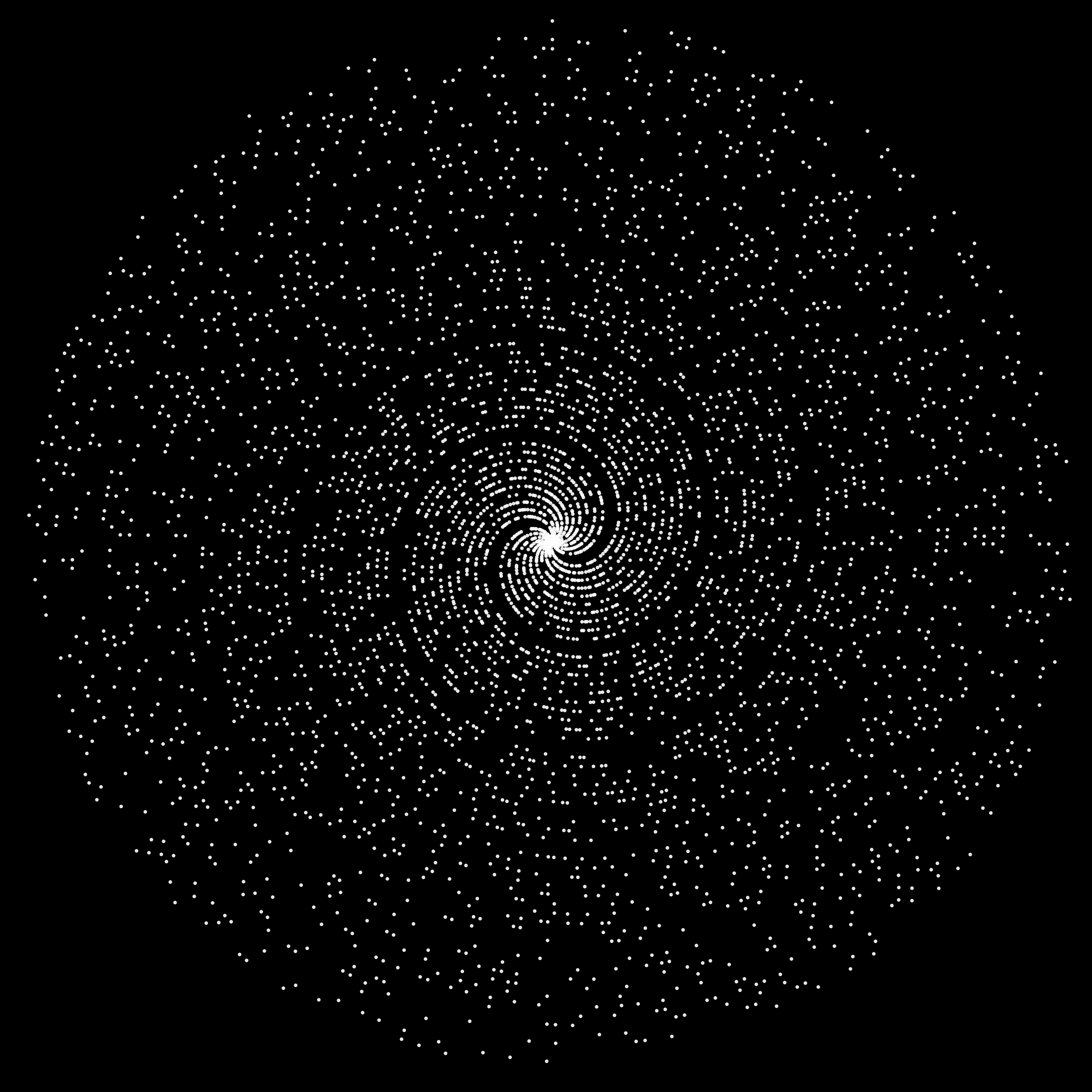A galaxy of prime numbers
A personal twist on the prime number spiral.
2023-04-15

Most mathematicians know that the representation of prime numbers in polar coordinates results in a cool-looking spiral.

One day I noticed that it looks quite like a galaxy: a "barred spiral galaxy" to be precise, like our own! Can we add more to it?
Star classes
Astronomers classify stars according to their spectral characteristics. I enjoy astronomy, and I am (partially) confident they know what they are doing.
The following can be found on Wikipedia [1], and is a list of star classes in order of temperature:
| Star class | Chromaticity | Percentage |
|---|---|---|
| O | blue | 0.00003% |
| B | bluish white | 0.12% |
| A | white | 0.61% |
| F | yellowish white | 3.00% |
| G | yellow | 7.60% |
| K | light orange | 12.00% |
| M | yellowish white | 76.00% |
A cool fact is that they can be memorised with the mnemonic "Our Bright Astronomers Frequently Generate Killer Mnemonics!" and to each class corresponds a different color ("chromaticity"). That is not how we see them from earth, filtered by the atmosphere, but rather how they look from space. In the words of Mitchell Charity [2],
The colors here are for the big balls of hot gas in space, rather than the pin-pricks of light in the local sky.
These pesky astronomers are clearly having fun and we are missing on it.
Prime number classes
My idea was to compare the frequency of star classes to the frequency of (some) prime number classes, and to each associate the respective chromaticity. This is a tricky business: to build an interesting plot we should use meaningful classes, but also keep them close to the star classes frequencies.
How many primes?
I noticed that adding too many prime numbers makes for a weird-looking spiral. Doing some tests, stopping at around returned the closest thing to our galaxy. There are primes up to , and we must keep it in mind to get matching percentages.
Which primes?
Now, we have to find the correct prime number classes. Remember that we are considering all primes up to : what is the frequency of each class? For the algebra nerds among us, this table represents all candidate classes and my conclusions. The wisest among you might wish to skip it.
| Prime number class | Percentage | Well-known? |
|---|---|---|
| Balanced | 4.95% | ❌ |
| Circular primes | 0.79% | ❌ |
| Cousin primes | 27.62% | ❌ |
| Cullen primes | 0.000025% | ❌ |
| Emirps (reversible primes) | 23.32% | ❌ |
| Even primes | 0.000025% | ✅ |
| Fermat primes | 0.12% | ✅ |
| Fibonacci primes | 0.19% | ✅ |
| Happy primes | 16.35% | ❌ |
| Mersenne primes | 0.10% | ✅ |
| Palindromic primes | 1.67% | ❌ |
| Pythagorean primes | 49.41% | ❌ |
| Primorial primes | 0.21% | ❌ |
| Safe primes | 7.76% | ✅ |
| Sophie-Germain primes | 13.44% | ✅ |
| Strobogrammatic primes | 0.17% | ❌ |
| Strong primes | 48.94% | ✅ |
| Twin primes | 28.10% | ✅ |
Let us have a look at the lucky winners.
Circular primes are stubborn numbers that keep being prime even if one rotates their digits. An example is , but also .
Even primes are those primes that are also odd. Unsurprisingly, is the only one.
Mersenne primes are those of form for some integer , they are very well-known for the (original) Mersenne conjecture.
Palindromic primes are primes where their palindrome is also prime. They are not well-known, even though Belphegor's Prime has some fame. A fun fact: palyndromic primes whose center is are called beastly palindromic primes. Perhaps a fitting name.
Safe primes are those primes of form , where is another prime. They are of strong cryptographic interest.
Sophie-Germain primes are the converse of safe primes, they are primes such that is another prime. Of course, they share the relevance of safe primes.
All comparisons drawn, we get the following result.
| Star class | Frequency | Prime number class | Frequency |
|---|---|---|---|
| O | 0.00003% | Even primes | 0.000025% |
| B | 0.12% | Mersenne primes | 0.12% |
| A | 0.61% | Circular primes | 0.79% |
| F | 3.00% | Palindromic primes | 1.67% |
| G | 7.60% | Safe primes | 7.76% |
| K | 12.00% | Sophie-Germaine primes | 13.44% |
| M | 76.00% | all other primes | 76.21...% |
Plotting the galaxy
We now have everything we need: our seven prime number classes, their respective colors, and the interval . All that remains is to plot them. This just takes a few lines in Python, resulting in the picture below.
